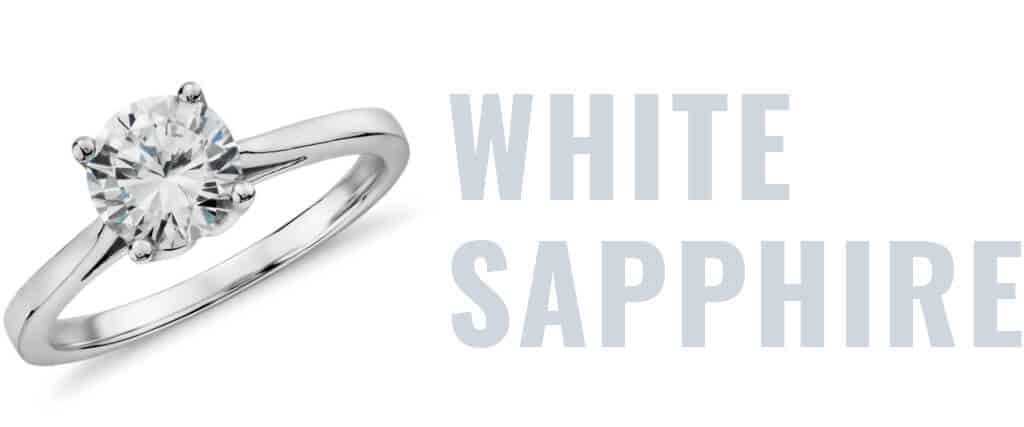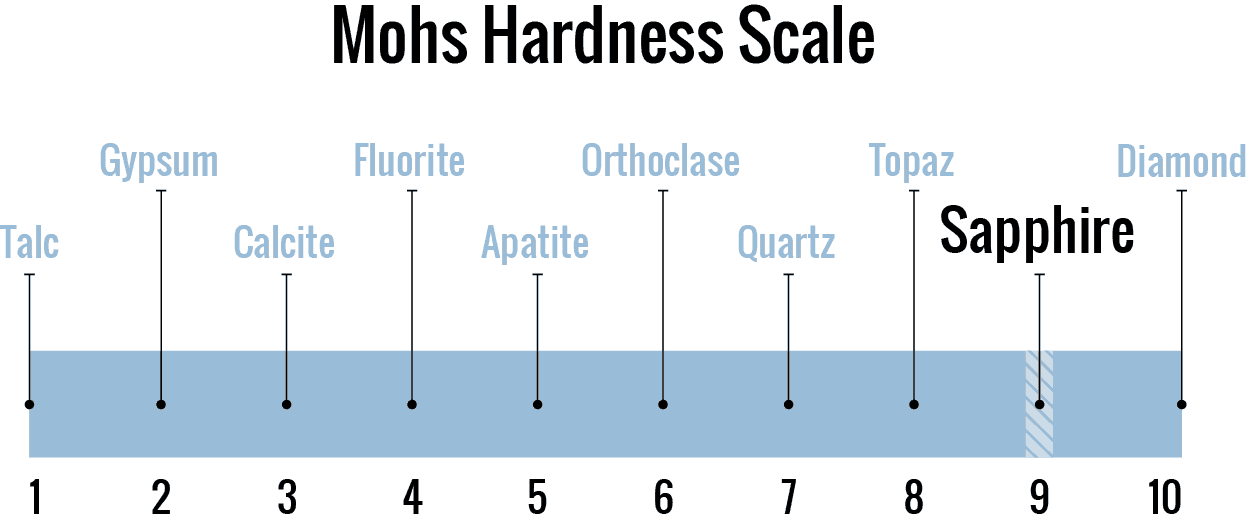White sapphires are a unique and increasingly popular alternative to traditional diamonds, especially for engagement rings and fine jewelry. They are a colorless, transparent form of the mineral corundum, which is the same mineral family to which colored sapphires and rubies belong. When buying a white sapphire, pay close attention to its cut, clarity, and carat size, just as you would with a diamond. Reputable jewelers and certified online stores are your safest bet for a quality purchase.
When compared to diamonds, white sapphires are generally less brilliant and lack the same level of fire or sparkle. They are also softer, ranking 9 on the Mohs scale compared to a diamond’s 10, making them slightly less durable. However, they are considerably more affordable than diamonds, which makes them an attractive option for those on a budget. Be wary of sellers who might try to pass off a white sapphire as a diamond, as the two stones, although similar in appearance, have distinct differences in durability, brilliance, and price. Always ask for a gemological certificate to confirm the stone’s identity.

Bottom Line Recommendation:
Although white sapphires can look appealing to some, we recommend considering a diamond for beautiful jewelry that can be worn every day and will last for years. We suggest purchasing a diamond from a reputable and reliable vendor like James Allen or Blue Nile.
For example, this classic tapered four prong white gold engagement ring from Blue Nile is simple and stunning, or you can choose a more decorative style with a halo ring like this one from James Allen. If you have questions about purchasing a diamond, don’t hesitate to contact us.
What is White Sapphire?
A white sapphire is a colorless sapphire. Although sapphires are usually thought of as a blue gemstone, they naturally occur in a variety of colors, including yellow, green, pink and white.
As a part of the corundum family of minerals, sapphires are a type of aluminium oxide containing traces of titanium, iron, magnesium, copper and chromium. The minerals present in the stone’s composition help designate its color.
White sapphires are often used as a diamond substitute thanks to their lack of color and lower price than diamonds. From a color and cut perspective, a sapphire ring offers a similar look to diamond jewelry with a few small compromises.
Why you should trust us
In general, white sapphires are much cheaper than diamonds. In most cases, white sapphires are actually yellow or grey stones that have been heat treated or chemically treated, meaning that they undergo a specific process to achieve their clear color.
Although natural white sapphires exist, they’re incredibly rare. Most natural sapphires are found in Southeast Asia, Africa, the Middle East and the western parts of the United States. There are two main types of white sapphire used in jewelry: natural and lab-created white sapphires.
Although they’re clear in color, white sapphires usually exhibit a cloudy white hue, providing one way to identify them compared to diamonds, topaz and moissanite. White sapphires measure 9 on the Mohs scale of hardness, making them durable enough for everyday wear.
Although this measurement may make a sapphire seem almost as hard as a diamond, in reality it’s somewhat misleading. As the GIA explains:
“Gem and mineral hardness is measured on the Mohs scale. The numbers are based on the relative ease or difficulty with which one mineral can be scratched by another. But the Mohs scale is deceptive. The steps between the minerals are not evenly spaced. For example, diamond is only one number away, but it’s many times harder than gems in the corundum family [such as sapphire].” Gemological Institute of America (GIA)
This means that despite their similar numbers on the Mohs scale, a diamond is significantly harder and more resistant to scratching than a sapphire. However, both stones are more than strong enough to be worn on a daily basis in an engagement ring.
The 4 C’s of White Sapphire
A diamond is evaluated based on so-called diamond 4 C’s (cut, color, clarity and carat). A white sapphire is evaluated differently.
The GIA, for example, does not grade white sapphires—instead, they only provide a report with basic details like color, carat weight and treatment. The 4 C’s are still important components to consider, but other characteristics, such as color tone, purity and level of saturation must be assessed as well.
Conventional standards for grading white sapphires also don’t exist in the same way they do for diamonds. The beauty of a color, for instance, is a subjective characteristic that varies from one person to another rather than something that can be objectively measured.
Because of this, we generally recommend evaluating a white sapphire (whether in a sapphire ring or any other type of jewelry) based on how it appeals to you without any magnification. To assist you in reviewing and assessing a white sapphire, use the guide below.
Cut
When it comes to colored gemstones, a range of cutting styles exist. Details and grading scales for each style of cutting and each colored gemstone would be a large and unfruitful undertaking for any lab entity.
Up to this point, laboratory grading systems have not found a need to have standard cut gradings for most colored gemstones.
When analyzing a white sapphire’s cut quality, take note of the following:
- Look for a white sapphire without a “window.” A window means the back of the stone can be seen through the table. When a window is present in a white sapphire, it indicates the stone has no light reflection or color.
- Review symmetry grade: assess the stone’s proportions and balance, including its length-to-width ratio.
- Assess for balance: is the culet off-center? Is the girdle uneven? These factors can all affect a white sapphire’s balance and are important to look for.
- Check table size: Look for a white sapphire with a table size between 33-67%, meaning the table is not too small or too large for light to adequately pass through.
- Watch for brilliance. Does light reflect and sparkle off the sapphire? Or is the stone dull?
Color
The hue of a colored gemstone is the most critical element when it comes to choosing a stone.
With white sapphire, the purer its colorlessness the better. Brilliance and fire matter less in white sapphires than they do in diamonds (and offer much less brilliance and fire than diamonds as well).
Judging a sapphire’s color should come down to what you see with the naked eye, and how the stone appeals to you. You’ll want to watch specifically for color-zoning. If the color is consistent throughout, then it is a more valuable stone. A white sapphire with uneven coloring is generally less appealing.
Many white sapphires are color treated, causing them to be less expensive than naturally occurring white sapphires. The stone may be heat-treated or chemically-treated, depending on the stone’s composition and the desired effect.
Clarity
Colored gemstones tend to have more inclusions and blemishes than diamonds, but most are only noticeable under 10x magnification.
To evaluate a white sapphire’s clarity, review the stone closely with your own eye to determine if any blemishes or inclusions are visible and if they take away from the stone’s overall beauty.
Carat
It’s important to remember that carat refers to the weight of the sapphire, not the size. A 1-carat sapphire equals 200 milligrams, or 0.2 grams, meaning it weighs in at nearly the same amount as a quarter of a raisin.
Since carat measures weight, depending on the sapphire’s shape and how its cut, two 1 carat sapphires could be quite different in size. Carat weight needs to be considered, but the overall beauty of the sapphire should carry more importance.
White Sapphires vs. Diamonds
At first glance, a similarly-sized diamond and a white sapphire can look similar as two colorless gemstones. However, there are a few significant differences between these two stones that can become more obvious when you compare them side by side.
First, and most importantly, diamonds offer much more brilliance and fire than white sapphires.
When it comes to refracting light, diamonds are by far the superior choice. If you were to place a high quality diamond next to a high quality sapphire, you could easily tell the difference between the two stones based on light refraction alone.
While a white sapphire will seem dull and lifeless, a diamond will reflect both white and colored light, making it naturally sparkle and catch your eye.
Second, diamonds rank a 10 on the Mohs scale of hardness. They’re nearly 100% resistant to scratching and will rarely ever need re-polishing. Sapphires, on the other hand, rank a 9 on the Mohs scale, meaning that they’re durable but not scratch resistant.

Third, over time, a sapphire (especially one that is worn daily) will acquire a buildup of dirt, soap and potentially even scratches. The sparkle and attraction of the sapphire don’t bode as well for daily use as they do for a diamond.
Finally, another difference between a white sapphire and a diamond is the price. In almost every case, a white sapphire will be less expensive than a diamond of the same size.
This means that if you’re not as concerned with the brilliance and beauty of the stone but care more about the size or having an untraditional gemstone, a white sapphire could make sense for you from a financial perspective.
| White Sapphire | Diamond | |
|---|---|---|
| Hardness (Mohs Scale) | 9 | 10 |
| Color | White, slightly cloudy | Clear |
| Brilliance (Refractive Index Score) | 1.77 RI | 2.42 RI |
| Scratch-resistant? | No | Yes |
Do White Sapphires Sparkle Like Diamonds?
A diamond will nearly always sparkle more than a white sapphire. White sapphires don’t refract light as well, meaning they’ll have much less brilliance and less of a visual sparkle when exposed to light. Their appearance is slightly milky and cloudy, compared to a diamond, which has a clear and pronounced brilliance.
If you put a white sapphire and a diamond next to each other in the same environment, you will notice some brilliance from the white sapphire. However, it’s significantly less than the brilliance you’ll notice from a diamond. This difference is particularly obvious in bright, direct light.
Diamonds score 2.42 on the refractive index , which measures brilliance. In comparison, sapphires have a refraction index of 1.77.
In general, if you’re looking for a gemstone that has obvious fire and brilliance, a diamond is the better choice. However, if you’re not as concerned about brilliance, a white sapphire can offer an appealing appearance that might better suit your needs and budget.
Can you tell the difference between diamond and white sapphire?
Yes, you can tell the difference between a diamond and white sapphire by looking at them side by side with the naked eye. A diamond has noticeably more brilliance (white light that reflects back to your eye) as well as fire (colored light that reflects back to your eye). Diamonds also look more transparent, while white sapphires have a more cloudy or dull appearance to them. Diamonds are more durable and scratch-resistant, whereas white sapphires can be scratched. White sapphires also show buildup of soap and dirt more easily.
White Sapphire Engagement Rings
When looking for a white sapphire engagement ring—or any engagement ring for that matter—one of the first choices to decide on is the shape. The shape refers to the formation of the gemstone, whether that’s oval, pear, cushion cut or something else.
The shape of a gemstone is primarily chosen based on personal preference. If you’re looking for a classic stone, you may opt for a round cut or princess cut. If you’re desiring something more unique, consider a pear or heart-shaped sapphire.
The cost and beauty of these stones differ, so it’s best to consider a few shapes before deciding which one is right for your engagement ring.
Popular Settings for White Sapphires
Like diamonds, white sapphires can be set in any type of metal: white gold, yellow gold, rose gold or platinum. When you’re considering different metals it’s important to keep in mind the style of the person who will be wearing the ring.
From a color perspective, the white sapphire should look colorless in relation to its setting, with a completely clear appearance.
In addition to the metal, you’ll need to choose the style of setting for the sapphire engagement ring. As with many other aspects of buying jewelry, personal preference plays a large role in determining the setting that you ultimately choose.
For a white sapphire ring, this halo setting with smaller stones from James Allen surrounding your center stone or this pavé setting with stones embedded into the band from Blue Nile are both quite popular.
White Sapphire Engagement Ring Inspiration:
- 18K White Gold Pave Tension Setting from Brian Gavin
- 18K White Gold Solitaire Setting from Brian Gavin
- 18K White Gold Split Channel Setting from Brian Gavin
White Sapphire Rarity and Pricing
Like other gemstones, the price of white sapphires can vary drastically based on their qualities, size and rarity. Below, we’ve explained how the size and rarity of a white sapphire can affect the price you should expect to pay and the sapphire’s availability.
White Sapphire Vs. Diamond Cost
White sapphires are significantly less expensive than diamonds, but diamonds are rarer, more valuable, and have more brilliance than white sapphires. A white sapphire is a less expensive alternative, but be aware that the stone won’t have the same brilliance or “wow” factor that a diamond provides. With larger white sapphires, such as anything over 1 carat, it’ll be easier to tell that it’s not a diamond. That’s because white sapphires lack brilliance and larger stones will be noticeably dull or “lifeless.”
While diamonds are more expensive, they can be worth the price to get a ring that offers brilliance and beauty. In the end, it’s up to you and what you desire for your engagement ring.
Are White Sapphires Rare?
Naturally occurring white sapphires of high quality are quite rare, and their prices reflect such rarity. Heat treated sapphires, on the other hand, are not nearly as rare and can be purchased for a reasonable price.
Higher carat white sapphires, like 3-4 carat stones, are much rarer, and that continues as carat weight increases. The prices for white sapphires reflect this rarity but still are still normally much less than diamonds.
If you’re looking for a white sapphire engagement ring or any other piece of jewelry, we suggest purchasing from a reputable vendor like Brian Gavin Diamonds.
If you’re looking for a stunning engagement ring that will maintain its beauty and value over the long-term, we highly recommend considering a diamond ring. For help in getting the best value for your budget and still purchasing a beautiful diamond, feel free to contact our experts today.
Frequently Asked Questions About White Sapphire
Are White Sapphires Good for Engagement Rings?
White sapphires are one of the most popular diamond alternatives, making them a perfectly fine choice for your engagement ring if you’d like a gemstone that looks similar to a diamond without a diamond’s price tag.
One unique aspect of a white sapphire ring is that it’s an unconventional choice. This could be a good thing or a bad thing, depending on you and your partner’s tastes in jewelry.
Another is that sapphire is the birthstone for September. Although blue sapphire is the conventional choice, a white sapphire engagement ring could be a unique choice if your partner has a birthday in September.
Despite their differences in fire and brilliance, most white sapphires will look similar to diamonds from afar. Just like with any gemstone, if you and your partner like it, there’s nothing stopping it from being a good choice for your engagement ring.
Are White Sapphires Better Than Cubic Zirconia?
White sapphires are often compared to cubic zirconia, one of several other common diamond alternatives. All in all, there are several major differences between white sapphires and cubic zirconia, most of which lean in the favor of white sapphires:
White sapphires are harder than cubic zirconia. White sapphires have a 9 rating on the Mohs scale of hardness, while cubic zirconia have a rating of between 8 and 8.5. This means that a white sapphire ring will offer a slight hardness and durability advantage.
White sapphires retain their color better than cubic zirconia. While white sapphires will usually attract more dirt and other particles than a diamond, they retain their clear tone better than cubic zirconia, which can start to look dull over time.
White sapphires do not refract light as well as cubic zirconia. In general, cubic zirconia are more likely to refract light than white sapphires, giving them a more visually obvious sparkle. However, cubic zirconia still sparkle significantly less than diamonds.
Finally, while white sapphires are often treated in a lab for color, they’re fundamentally natural gemstones. Cubic zirconia used in jewelry, on the other hand, are entirely artificial gemstones that are not sourced from any natural environment.
Cubic zirconia are also almost never used in any context other than as diamond alternatives, while white sapphires are a unique type of natural gemstone with their own appeal, popularity and history.
Do White Sapphires Get Cloudy?
White sapphires can pick up dirt, dust and residue from soaps and other cleaning products as time passes, causing them to lose some amount of their sparkle and shine. However, this can easily be reversed by adequately cleaning and caring for the sapphire.
What are Lab-Created White Sapphires?
As you’d expect from the name, lab-created white sapphires are white sapphire gemstones that have been made in a laboratory. Like other lab-created gemstones, lab-created white sapphires are more affordable than similar sapphires found in nature.
From a chemical perspective, lab-created white sapphires have an identical makeup to natural white sapphires. Despite this, they lack the story for a natural gemstone and, for many people, aren’t viewed as quite as desirable as a natural or only color-treated sapphire.
Here are more specific gemstone topics to browse:
- What to consider when buying gemstone jewelry
- What is there to know about a Sapphire gemstone
- Green Sapphire: What is it and how to get one?
- Pink Sapphire: How to get the best value?
- How to choose a Yellow Sapphire for an engagement ring?
- A complete guide to Blue Sapphire engagement rings
- What is a Ruby gemstone?
- How to buy green Emerald jewelry?
- Tips for buying Moonstone engagement rings
- How much do Amethyst gemstones cost?
- What is an Opal stone?
- How much to spend on a Peridot engagement ring?
- What’s the difference between Natural and Cultured Pearls?
- Pros & Cons of buying a Morganite engagement ring

- No questions asked returns within 30 days of shipment. James Allen will send you a paid shipping label to return the ring.
- Lifetime Warranty
- Free International Shipping
- Free prong tightening, repolishing, rhodium plating and cleaning every 6 months
- Provide insurance appraisals
- One free resizing within 60 days of purchase
- Free ring inscriptions
- Best-in-class high quality imagery of all diamonds in stock
- 24/7 Customer Service
- Best-in-class packaging


- No questions asked returns within 30 days of shipment. Blue Nile will send you a paid shipping label to return the ring.
- Lifetime Warranty
- Free Shipping
- Free prong tightening, repolishing, rhodium plating and cleaning every 6 months
- Provide insurance appraisal
- One free resizing within the first year of purchase
- High quality images of about half of their diamonds
- 24/7 Customer Service
- 100% credit towards future upgrades (must be at least double in value)
- Best in class fulfillment

Still afraid of getting ripped off?
Before you buy a diamond, get personal buying advice from industry veterans. We'll help you get the best diamond for the money.
Ask your diamond purchase question here
DISCLAIMER: We don't use your email for marketing. Period.
You Might Like
Diamond Prices: A Complete Guide
A diamonds’ price is determined primarily by the 4 Cs of the diamond. On the wholesale level, diamond prices are first based on a diamond shape and
The Best Places to Buy Engagement Rings
Buying an engagement ring is often one of the first major purchases in a person's life. The process can be fraught with tension as there are so m
1 Carat Diamond Price & Buying Guide
A wide range of 1 carat diamonds exist both in online markets and local diamond jewelry stores. Not only are there significant differences in beauty



